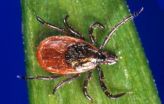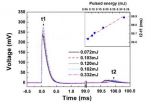(Press-News.org) CAMBRIDGE, Mass-- Whenever there is a major spill of oil into water, the two tend to mix into a suspension of tiny droplets, called an emulsion, that is extremely hard to separate — and that can cause severe damage to ecosystems. But MIT researchers have discovered a new, inexpensive way of getting the two fluids apart again.
Their newly developed membrane could be manufactured at industrial scale, and could process large quantities of the finely mixed materials back into pure oil and water. The process is described in the journal Scientific Reports by MIT professor Kripa Varanasi, graduate student Brian Solomon, and postdoc M. Nasim Hyder.
In addition to its possible role in cleaning up spills, the new method could also be used for routine drilling, such as in the deep ocean as well as on land, where water is injected into wells to help force oil out of deep rock formations. Typically, Varanasi explains, the mixed oil and water that's extracted is put in large tanks to allow separation by gravity; the oil gradually floats to the top, where it can be skimmed off.
That works well when the oil and water are "already large globs of stuff, already partly separated," Varanasi says. "The difficulty comes when you have what is called an emulsion, with very tiny droplets of oil stabilized in a water background, or water in an oil background. The difficulty significantly increases for nanoemulsions, where the drop sizes are below a micron."
To break down those emulsions, crews use de-emulsifiers, which can themselves be environmentally damaging. In the 2010 Deepwater Horizon oil spill in the Gulf of Mexico, for example, large amounts of dispersants and de-emulsifiers were dumped into the sea.
"After a while, [the oil] just disappeared," Varanasi says, "but people know it's hidden in the water, in these fine emulsions." In the case of land-based drilling, where so-called "produced water" from wells contains fine emulsions of oil, companies sometimes simply dilute the water until it meets regulatory standards for being discharged into waterways.
"It's a problem that's very challenging to the industry," Varanasi says, "both in terms of recovering the oil, and more importantly, not discharging the produced water into the environment."
The new approach developed by Varanasi's group uses membranes with hierarchical pore structures. The membranes combine a very thin layer of nanopores with a thicker layer of micropores to limit the passage of unwanted material while providing strength sufficient to withstand high pressure and throughput. The membranes can be made with contrasting wetting properties so their pores either attract oil and repel water, or vice versa.
"This allows one material to pass while blocking the other with little flow resistance," Varanasi says. The choice of membrane, or a combination of both, could be based on which material predominates in a particular situation, he explains.
The pores have to be smaller than the droplets in order to block them, Varanasi says — which, in the case of nanoemulsions, leads to very small pores and significant flow resistance, limiting the throughput. Throughput can be improved by increasing the pressure gradient or making the separation layer very thin, but past attempts to make such thin, small-pore membranes have yielded materials that tear even under nominal pressure. The team's solution: an ingenious process that makes large holes on one side that penetrate most of the way through the material, providing little resistance to flow, as well as nanoscale holes on the other surface, in contact with the emulsion to be separated. The thin layer with nanoscale pores allows for separation, and the thick layer with large pores provides mechanical support.
The approach can be adapted to industrial processes used today for making large membranes in a high-volume, roll-to-roll manufacturing system, so it should be relatively easy to achieve large-scale production, Varanasi says.
A polymer solution is poured onto a glass plate, Hyder explains; this casting plate is then immersed in a nonsolvent bath to induce precipitation to form a film. The technique creates a bilayered polymer phase: One layer is polymer-rich, and one is not. As they precipitate out, the polymer-rich phase develops the smaller pores; the polymer-lean phase makes the larger ones. Since the solutions form a single sheet of film, there is no need for bonding layers together, which can result in a weaker filter.
"There is no separate layer, it's completely integrated, so the mechanical support is integral," Hyder says. As a final stage, a different polymer is added to give the material — including the lining of the pores — surfaces that attract or repel oil and water. The skin layer thickness can be further optimized using polymeric pore formers to enhance throughput.
Solomon performed experiments showing the effectiveness of the membranes in separating nanoemulsions while maintaining integrity at high pressure. The team used various techniques — including differential scanning calorimetry, dynamic light scattering, and microscopy — to test the separation efficiency, showing more than 99.9 percent separation.
Microscopy images show the membrane in operation, with dye added to the water to make the droplets more obvious. Within seconds, an oil-water mixture that is heavily clouded becomes perfectly clear, as the water passes through the membrane, leaving pure oil behind. As shown in the microscope images, Solomon says, "We're not only getting rid of the droplets you can see, but also smaller ones," which contribute to the cloudy appearance.
The team is working with Shell, which supported the research through the MIT Energy Initiative, to further test the material.
INFORMATION:
Separating finely mixed oil and water
Membrane developed by MIT researchers can separate even highly mixed fine oil-spill residues
2014-07-01
ELSE PRESS RELEASES FROM THIS DATE:
Mayo Clinic researchers reveal treasure trove of genes key to kidney cancer
2014-07-01
JACKSONVILLE, Fla. — A genomic analysis of clear cell renal cell carcinoma (ccRCC), the most common form of kidney cancer, from 72 patients has uncovered 31 genes that are key to development, growth and spread of the cancer, say researchers from Mayo Clinic in Florida. Eight of these genes had not been previously linked to kidney cancer, and six other genes were never known to be involved in any form of cancer.
MULTIMEDIA ALERT: Video and audio are available for download on the Mayo Clinic News Network.
Their study, in the journal Oncotarget, is the most extensive analysis ...
Alcohol use disorders linked to decreased 'work trajectory'
2014-07-01
July 1, 2014 - John D. Meyer, MD, MPH, of Icahn-Mount Sinai School of Medicine, New York, and Miriam Mutambudzi, PhD, MPH, of Johns Hopkins School of Medicine, Baltimore, studied the relationship between occupation and AUDs in workers followed up from early adulthood to middle age. The study focused on the "substantive complexity" of work as an indicator of work trajectory—whether individuals were progressing in their careers in terms of factors such as decision latitude and expanded work abilities.
Based on factors such as drinking more than intended or unsuccessful ...
NIH study reveals gene critical to the early development of cilia
2014-07-01
Researchers at the National Eye Institute (NEI) have described the functions of a gene responsible for anchoring cilia – sensory hair-like extensions present on almost every cell of the body. They show in a mouse model that without the gene Cc2d2a, cilia throughout the body failed to grow, and the mice died during the embryonic stage. The finding adds to an expanding body of knowledge about ciliopathies, a class of genetic disorders that result from defects in the structure or function of cilia. NEI is part of the National Institutes of Health.
The findings are published ...
Smartphone app may revolutionize mental health treatment
2014-07-01
Mental illness accounts for 90 percent of all reported suicides and places the largest burden of any disease on social and economic infrastructures worldwide, according to the World Health Organization. There is a dire need for support services to assist clinicians in the evaluation and treatment of those suffering from mental illness.
New technology developed by researchers at Tel Aviv University is poised to transform the way in which patients with mental illnesses are monitored and treated by clinicians. Dr. Uri Nevo, research team engineer Keren Sela, and scientists ...
Muscle-powered bio-bots walk on command
2014-07-01
Engineers at the University of Illinois at Urbana-Champaign demonstrated a class of walking "bio-bots" powered by muscle cells and controlled with electrical pulses, giving researchers unprecedented command over their function. The group published its work in the online early edition of Proceedings of the National Academy of Science.
"Biological actuation driven by cells is a fundamental need for any kind of biological machine you want to build," said study leader Rashid Bashir, Abel Bliss Professor and head of bioengineering at the U. of I. "We're trying to integrate ...
Reducing deer populations may reduce risk of Lyme disease
2014-07-01
Since white-tailed deer serve as the primary host for the adult blacklegged tick (Ixodes scapularis) — the vector for Lyme disease — scientists have wondered whether reducing the number of deer in a given area would also mean fewer cases of Lyme disease. Now, after a 13-year study was conducted, researchers in Connecticut have found that reduced deer populations can indeed lead to a reduction in Lyme disease cases. The results of their study are published in the Journal of Medical Entomology .
The researchers surveyed 90% of all permanent residents in a Connecticut ...
Enlightening cancer cells
2014-07-01
This news release is available in German.
Harald Janovjak, Assistant Professor at IST Austria, together with Michael Grusch, Associate Professor at the Institute of Cancer Research of the Medical University of Vienna, "remote-controlled" the behaviour of cancer cells with light, as reported this week in EMBO Journal (DOI: 10.15252/embj.201387695). This work is the first application of the new field of optogenetics to cancer research.
To understand the dynamics of cellular signaling, researchers need to activate and inactivate membrane receptor proteins, which ...
A new method to detect infrared energy using a nanoporous ZnO/n-Si photodetector
2014-07-01
Experiments aimed at devising new types of photodetectors have been triggered by the increasing use of optoelectronic devices in personal electronics, cameras, medical equipment, computers and by the military. Professor Zhao Kun and co-researchers at the State Key Laboratory of Petroleum Resource and Prospecting, part of the China University of Petroleum in Beijing, have proposed a new type of infrared photodetector.
Photodetectors, which can convert photons to electrical signals, are used to observe and measure the wavelength or energy of light, including infrared light, ...
Drink walkers do it because their mates think it's okay: QUT study
2014-07-01
Friends may be the key to stopping their mates drink walking, a risky behaviour that kills on average two Australians every week, a QUT study has found.
Researcher Dr Ioni Lewis, from QUT's Centre for Accident Research & Road Safety - Queensland (CARRS-Q), said in a survey of young people aged 17 to 25, friends were the strongest influence on their intentions to drink walk.
"Drink walking, or walking while intoxicated in a public place, is linked to increased risk of injury and fatality," Dr Lewis said.
In a survey, published in Transportation Research, more than ...
EORTC presents European solution for effective cancer drug development
2014-07-01
Drug developers are facing the perfect storm. They are confronted with major patent expiries, increased payer scrutiny, changing priorities, shifting business models, increased risk averseness, increased clinical trial costs, not to mention issues concerning R&D productivity. There needs to be a better way to identify new candidate drugs. There needs to be a new drug development pathway that is compatible with research aimed at understanding the biology of a cancer and simultaneously able to support the design and conduct of subsequent confirmatory trials, but building ...
LAST 30 PRESS RELEASES:
iPS cells from dish to freezer and back
Deep neural networks enable accurate pricing of American options under stochastic volatility
Collective risk resonance in Chinese stock sectors uncovered through higher-order network analysis
Does CPU impact systemic risk contributions of Chinese sectors? Evidence from mixed frequency methods with asymmetric tail long memory
General intelligence framework to predict virus adaptation based on a genome language model
Antibiotic resistance is ancient, ecological, and deeply connected to human activity, new review shows
Vapes, pouches, heated tobacco, shisha, cigarettes: nicotine in all forms is toxic to the heart and blood vessels
From powder to planet: University of Modena engineers forge a low-carbon future for advanced metal manufacturing
Super strain-resistant superconductors
Pre-school health programme does not improve children’s diet or physical activity, prompting call for policy changes, study finds
Autumn clock change linked to reduction in certain health conditions
AI images of doctors can exaggerate and reinforce existing stereotypes
Where medicine meets melody – how lullabies help babies and parents in intensive care
We may never be able to tell if AI becomes conscious, argues philosopher
AI video translation shows promise but humans still hold the edge
Deep ocean earthquakes drive Southern Ocean’s massive phytoplankton blooms, study finds
Without campus leftovers to pick through, the beaks of this bird changed shape during the pandemic
High-dose antibiotic does not reduce mortality in tuberculous meningitis
How many insects fly in the sky above the USA?
Could cheese protect your brain health?
Who faces more difficulty recovering from stroke?
Colliding galaxies create the brightest, fastest growing black holes at their center
New BrainHealth research reveals tradeoffs on sleep with cannabis use for chronic pain
Aging-US now on ResearchGate, enhancing visibility for authors and readers
'Molecular glue' stabilizes protein that inhibits development of non-small cell lung cancer
Mount Sinai Health System is recognized in 2025 Chime Digital Health Most Wired survey
From prey to predator: How carnivores spread beneficial fungi
Menopause symptoms may be frequent and have negative effects, according to female endurance athletes
US Congressmembers’ responses on X to mass shooting events differ along party lines
KAIST-UEL team develops “origami” airless wheel to explore lunar caves
[Press-News.org] Separating finely mixed oil and waterMembrane developed by MIT researchers can separate even highly mixed fine oil-spill residues



